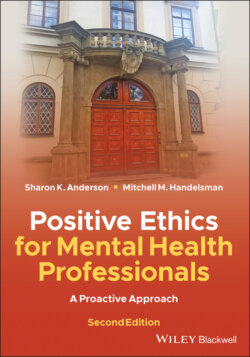Читать книгу Positive Ethics for Mental Health Professionals - Sharon K. Anderson - Страница 19
Activity
ОглавлениеWe don’t know you. We don’t know the courses you have taken or the disciplines you have studied. Regardless, we want to help you uncover, explore, and articulate what is in your core and consider how to integrate your ethical and professional selves in some systematic, integrative, and fulfilling ways. Although we focus on universal ethical issues that all psychotherapists face, your professional/ethical identity is yours alone. We invite you to be partners with us and to explore your identity actively. Indeed, the key to your learning experience will be your reactions to what we have written. To this end, we have provided three types of activities throughout the book.
The first activity is titled Journal Entries. This activity offers the most formal way to explore and take more responsibility for your learning from this book. You can keep your journal in a hard-copy notebook, a computer file, or on Instagram. The format doesn’t matter—what matters is taking the opportunities to self-reflect and explore. We will make some suggestions for journal entries, but we encourage you to be willing to write down some of your reactions and thoughts about what you read. Some of you might do this already in various aspects of your life. Or, you may never have tried writing stuff down. You might feel more comfortable talking through your thoughts. You may want to record your thoughts via voice and transcribe them later. The point is, we think it’s important for you to reflect, to think more intentionally, mindfully, and deeply about the issues we’re exploring. We encourage you to avoid the human tendency to read a passage and immediately say things like, “Got it,” or “Yep, that’s me!”
The second type of activity we call Food for Thought. These are opportunities for you to sit back and reflect upon what you’re reading and how you relate to it. Although not as formal as journal entries, these reflections can really contribute to your learning. You might think of them as extra consideration of the next step on the staircase, whereas the journal entries involve building handrails or sanding down rough edges on the steps.
The third type of activity we call Red Flag and Green Flag stories, which we introduce in Chapter 4. This is where we articulate some of the tripping points (red flags) and ways to prevent, mitigate, or transcend tripping points and achieve ethical excellence (green flags). The flag stories contain specific examples of behaviors and attitudes that you can think about, react to, and expand upon.
If you are reading this book for a class, your professor may ask you to do some additional entries or exercises, or ask you to share your work as part of a class discussion. The purpose of every activity is to facilitate the development of your professional/ethical identity and ethical acculturation—to explore yourself, the culture of psychotherapy, and/or the relationship between the two. As you respond to our prompts, remember that there are very few clearly right or wrong answers; we’ve left most of the questions open-ended to facilitate your exploration.
A note about the process of activities: We encourage you to take your time and reflect on what is being asked or what we offer through one of the flag stories. You don’t want to feel like it is absolutely necessary to answer every question in every activity or even to do every activity. You choose what is most meaningful at this time, knowing that you may come back to the chapter at a later time to do some additional reflection. However, we believe the more you do, the more you will benefit from this book. Think of these activities as walking up some stairs on the staircase or entering and exploring one of the rooms in the mansion. We intend the exercises to have multiple benefits, including growing self-understanding about who you are and who you want to be as an ethical professional.
